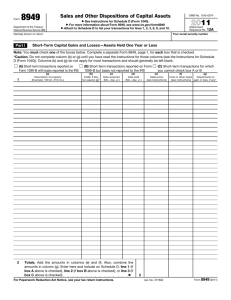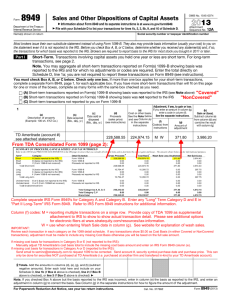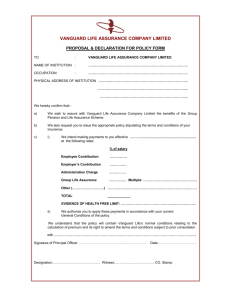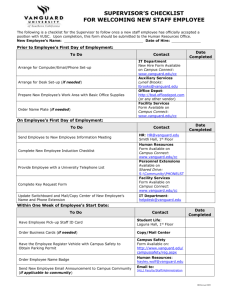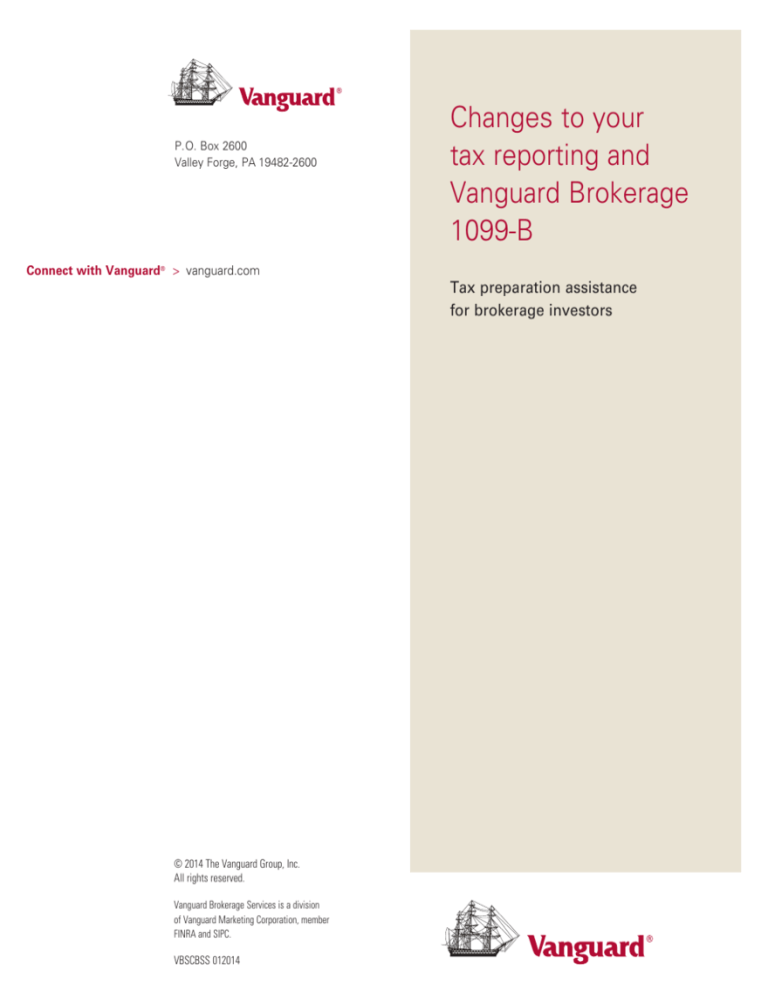
P.O. Box 2600
Valley Forge, PA 19482-2600
Connect with Vanguard® > vanguard.com
© 2014 The Vanguard Group, Inc.
All rights reserved.
Vanguard Brokerage Services is a division
of Vanguard Marketing Corporation, member
FINRA and SIPC.
VBSCBSS 012014
Changes to your
tax reporting and
Vanguard Brokerage
1099-B
Tax preparation assistance
for brokerage investors
Reminders for using
Form 1099-B
Regulatory changes to cost basis reporting, which took
effect in 2011, triggered updates to IRS Form 1099-B, part
of the Vanguard Brokerage Tax Information Statement.
Vanguard is required to report cost basis information to
the IRS on Form 1099-B for shares that were acquired
on or after the dates listed below and later sold.
Effective dates for covered shares
Shares acquired beginning January 1, 2011:
For more information
Please see IRS Publication 550, Investment Income
and Expenses, for additional information. For copies,
call the IRS at 800-829-3676 or visit irs.gov.
Questions?
A Vanguard Brokerage investment professional will be
happy to answer questions about information provided
on your Form 1099-B. Call us at 800-662-2739 on
business days from 8 a.m. to 10 p.m. or on Saturdays
from 9 a.m. to 4 p.m., Eastern time.
•S
tocks.*
•E
xchange-traded funds (ETFs) organized as unit
investment trusts (UITs).*
Shares acquired beginning January 1, 2012:
•M
utual funds.**
• ETFs organized as regulated investment companies
other than UITs.
• Stocks acquired through a dividend reinvestment
plan (DRIP).
Bonds and options acquired
beginning January 1, 2014:
•L
ess complex bonds.***
• Most options.
Bonds and options acquired
beginning January 1, 2016:
• More complex bonds.†
• Certain options involving more complex bonds.
Visit our tax center
Go to vanguard.com/taxcenter
for Vanguard tax-related
information, forms, and the
Tax Information Statement
reference guide.
Shares that were acquired before these dates (noncovered shares) may also have cost basis information, but
this information won’t be reported to the IRS.
Sign up for e-delivery
Vanguard applies default cost basis methods unless
you’ve selected a specific method. Average cost is the
default for mutual funds, while first in, first out (FIFO)
is the default for other holdings. Consult a tax advisor
to determine the best method for you to use.
You can now receive your
Vanguard tax forms and tax
brochures by e-delivery. Sign up
at vanguard.com/edelivery.
*If your stock or ETF organized as a UIT is part of a DRIP, it isn’t
considered covered until January 1, 2012.
**Excluding money market funds.
***Generally, these are bonds and other debt obligations with fixed yield
and maturity dates.
†Generally, these are bonds and other debt obligations without fixed
yield and maturity dates.
Adjustments to cost basis
Vanguard is required to make certain adjustments
to the initial cost basis of covered securities
acquired in an account. We’ll adjust the basis of
securities for commissions and transfer taxes
related to the acquisition of the security. We’ll
also adjust the basis for any organizational actions
reported by the issuer. However, we generally
won’t adjust for transactions, elections, or other
events occurring outside the account.
Wash sales: Under tax rules, the deduction
for a loss realized on the sale of a security is
disallowed if, within 30 days before or after the
sale, a substantially identical security is acquired.
Any loss that is disallowed is added to the basis
of the acquired security. Vanguard will adjust the
basis of securities held in the account for losses
that are disallowed due to a wash sale, but only
if both the purchase and sale of an identical
security (a security with the same CUSIP) occur
in the same account. You must adjust the basis
of a security if a wash sale occurs as a result of:
• The purchase of a substantially identical
security that isn’t an identical security.
• A purchase that occurs in a different account
than the sale.
Another adjustment we’ll make: Vanguard will
also adjust the basis of a security issued by a
regulated investment company (RIC) or real estate
investment trust (REIT) that has undistributed
long-term capital gains during the year.
A. For shares of noncovered securities that
you may have sold, Vanguard will report the
information to you on Form 1099-B, when available.
However, Vanguard won’t report any basis
information that we have to the IRS on noncovered
shares. For these shares, you must determine the
cost basis information, and you may use another
cost basis method if you meet the requirements. For
covered shares, you must use Vanguard’s default
cost basis method unless you provided Vanguard
with another cost basis method at the time of the
sale. However, it’s important to understand that
what Vanguard is required to report to the IRS may
be different from what you must report to the IRS,
and you may need to make adjustments on IRS
Form 8949. Having your own records will certainly
help you make these adjustments, if any are needed.
Adjustments we won’t make: Vanguard doesn’t
consider constructive sales or mark-to-market
adjustments in determining the holding period of
securities sold for a gain or loss.
Frequently asked questions
Q. What adjustments haven’t been
incorporated into my cost basis?
Q. What’s a wash sale?
A. Brokers are only required to make some of
“substantially identical” security is purchased up
to 30 days before or 30 days after the date of the
sale, the loss is disallowed and can’t be deducted.
The disallowed loss is added to the basis of the
purchased security, thereby reducing future gains or
increasing future losses. Vanguard will make some,
but not all, of the adjustments for wash sales.
the possible wash sale adjustments that must
be considered in order to file your income tax
return. We won’t make wash sale adjustments
when the purchases and sale occur in different
accounts or when they are between substantially
identical securities that have different CUSIPs.
We also won’t make the following adjustments:
adjustments.
short-term losses.
• Hedging transactions or offsetting positions.
(See IRS Publication 550.)
7
Form 1099-B has up to five separate sections
to clearly identify whether the cost basis is
reported to you and the IRS, reported only to
you, or not available. These separate sections are
created dynamically based on the activity in your
account and will make it easier for you to complete
IRS Form 8949, Sales and Other Dispositions of
Capital Assets.
You must determine short-term or long-term and
report on Form 8949, Part I, with Box B checked,
or on Form 8949, Part II, with Box E checked, as
appropriate.
Section 1: Short-term transactions for which basis
is reported to the IRS—Report on Form 8949, Part I,
with Box A checked.
Box 1c is labeled “Short-Term,” and Box 6b is
labeled “Basis reported to IRS.”
Section 2: Short-term transactions for which basis
is not reported to the IRS—Report on Form 8949,
Part I, with Box B checked.
after January 1, 2012, which are subsequently sold.
All other information is provided to you as a courtesy
and isn’t sent to the IRS.
8
Vanguard will display cost basis information for
covered and noncovered shares for securities
on Form 1099-B if we have complete information.
If a portion of the position doesn’t contain
complete cost basis information, it’ll be reported
in Section 5 on Form 1099-B.
Vanguard is required to report the sales of
covered securities by S corporations if the
securities were acquired on or after January 1,
2012. Prior to the 2012 tax year, you received
a courtesy Form 1099 Consolidated. Now we’ll
identify the covered transactions to show which
ones will be reported to the IRS.
We’re required to treat your corporation as an
S corporation unless we received a Form W-9
indicating that it’s a C corporation.
Box 1c is labeled “Long-Term,” and Box 6b is
labeled “Basis reported to IRS.”
A. We report information about shares purchased
How Vanguard displays
cost basis information
S corporation reporting
Section 3: Long-term transactions for which basis
is reported to the IRS—Report on Form 8949,
Part II, with Box D checked.
Q. What information does Vanguard report
to the IRS about S corporations?
• Constructive sales and mark-to-market
Section 5: Transactions for which basis is not
reported to the IRS and for which short-term or
long-term determination is unknown (to Vanguard).
Box 1c is labeled “Short-Term,” and Box 6a is
labeled “Noncovered security.” The information in
Boxes 1b, 1c, 3, and 5 reflects Vanguard’s records
and won’t be reported to the IRS. You’re solely
responsible for the recordkeeping and accuracy of
this information.
A. When a security is sold for a loss and a
• RIC and REIT adjustments with respect to certain
6
5 separate sections of Form 1099-B
Q. I track my own cost basis; do I have
to use Vanguard’s information?
Nondividend distributions (return of capital):
Vanguard will make adjustments to your cost basis
by the amount of the nontaxable distribution for
the purpose of calculating the gain or loss once
the security is sold. These adjustments mainly
occur due to return of capital. The amount that
exceeds your adjusted basis is reported as long- or
short-term capital gain on Schedule D, depending
on your holding period. Please review your Form
1099-DIV, Box 3 to determine if any dividends
received represent a return of capital.
Section 4: Long-term transactions for which basis
is not reported to the IRS—Report on Form 8949,
Part II, with Box E checked.
Box 1c is labeled “Long-Term,” and Box 6a is
labeled “Noncovered security.” The information in
Boxes 1b, 1c, 3, and 5 reflects Vanguard’s records
and won’t be reported to the IRS. You’re solely
responsible for the recordkeeping and accuracy of
this information.
2
3
How to report a sale of shares purchased over time
Short-term covered securities
In the example below, you’ve purchased 500 shares of IBM Corporation over time. You then sell all 500 shares
in one transaction. Prior to 2011, the proceeds were reported to you in one section on the 1099-B,
but this is no longer the case. The sale must now be reported by us in the appropriate sections of Form 1099-B,
and you must report it to the IRS on the appropriately checked Form 8949 and on Schedule D.
TransactionQuantity
Date
Buy3001/2/2009
Buy1003/1/2013*
Buy1004/1/2013*
Long-term noncovered securities
Form 1099-B
Long-term noncovered:
• Reported to you in Section 4 of Form 1099-B.
• Reported to the IRS on Form 8949, Part II, with Box E checked.
A
Short-term covered:
• Reported to you in Section 1 of Form 1099-B.
• Reported to the IRS on Form 8949, Part I, with Box A checked.
A
C
B
D
E
H
A
A
C
B
D
E
H
Form 8949
Sell50011/1/2013
Use the appropriate Form 1099-B (see top images to the right), your personal records, and the instructions
below to complete IRS Form 8949 (middle images to the right), and Schedule D (bottom images to the right)
for covered or noncovered shares. Enter the details of each transaction on a separate line of Form 8949
(see the actual form for more detailed instructions and for exceptions). Use as many Forms 8949 as needed.
A Description of property. Enter the description
F
shown on your Form 1099-B, Box 1e and Box 8.
B
C
Date acquired. Enter the date you purchased your
shares shown on your Form 1099-B, Box 1b.
instructions for Form 8949 for a detailed
listing of possible codes to be entered.
G
Date sold. Enter the date of the sale or exchange
shown on your Form 1099-B, Box 1a.
D Sales price. Enter the sales price reported to
you on Form 1099-B, Box 2a.
E
Cost or other basis. Enter the cost basis
amount shown on your Form 1099-B, Box 3,
if available. Otherwise, use your personal
records such as past statements, transaction
history, and your tax returns to obtain cost
information.
Code, if any. Please see the IRS
H
Adjustments to gain or loss, if any. Enter
any adjustments to gain or loss required
because of the code entered in column (f).
Enter negative amounts in parentheses.
A
A
B
C
D
E
F
G
B
C
D
E
F
G
H
H
Schedule D
Gain/Loss. Enter this amount in column (h)
on both the Form 8949 and Schedule D.
After subtotaling columns (d), (e), (g), and (h) on
Form 8949, transfer the figures to those same
columns on Schedule D.
The sample forms used in this brochure are
for illustration only.
D
D
E
G
E
G
H
H
*A sale that represents multiple acquisition dates will display as blank in Box 1b of Form 1099-B,
and as “various” on Form 8949.
4
5
How to report a sale of shares purchased over time
Short-term covered securities
In the example below, you’ve purchased 500 shares of IBM Corporation over time. You then sell all 500 shares
in one transaction. Prior to 2011, the proceeds were reported to you in one section on the 1099-B,
but this is no longer the case. The sale must now be reported by us in the appropriate sections of Form 1099-B,
and you must report it to the IRS on the appropriately checked Form 8949 and on Schedule D.
TransactionQuantity
Date
Buy3001/2/2009
Buy1003/1/2013*
Buy1004/1/2013*
Long-term noncovered securities
Form 1099-B
Long-term noncovered:
• Reported to you in Section 4 of Form 1099-B.
• Reported to the IRS on Form 8949, Part II, with Box E checked.
A
Short-term covered:
• Reported to you in Section 1 of Form 1099-B.
• Reported to the IRS on Form 8949, Part I, with Box A checked.
A
C
B
D
E
H
A
A
C
B
D
E
H
Form 8949
Sell50011/1/2013
Use the appropriate Form 1099-B (see top images to the right), your personal records, and the instructions
below to complete IRS Form 8949 (middle images to the right), and Schedule D (bottom images to the right)
for covered or noncovered shares. Enter the details of each transaction on a separate line of Form 8949
(see the actual form for more detailed instructions and for exceptions). Use as many Forms 8949 as needed.
A Description of property. Enter the description
F
shown on your Form 1099-B, Box 1e and Box 8.
B
C
Date acquired. Enter the date you purchased your
shares shown on your Form 1099-B, Box 1b.
instructions for Form 8949 for a detailed
listing of possible codes to be entered.
G
Date sold. Enter the date of the sale or exchange
shown on your Form 1099-B, Box 1a.
D Sales price. Enter the sales price reported to
you on Form 1099-B, Box 2a.
E
Cost or other basis. Enter the cost basis
amount shown on your Form 1099-B, Box 3,
if available. Otherwise, use your personal
records such as past statements, transaction
history, and your tax returns to obtain cost
information.
Code, if any. Please see the IRS
H
Adjustments to gain or loss, if any. Enter
any adjustments to gain or loss required
because of the code entered in column (f).
Enter negative amounts in parentheses.
A
A
B
C
D
E
F
G
B
C
D
E
F
G
H
H
Schedule D
Gain/Loss. Enter this amount in column (h)
on both the Form 8949 and Schedule D.
After subtotaling columns (d), (e), (g), and (h) on
Form 8949, transfer the figures to those same
columns on Schedule D.
The sample forms used in this brochure are
for illustration only.
D
D
E
G
E
G
H
H
*A sale that represents multiple acquisition dates will display as blank in Box 1b of Form 1099-B,
and as “various” on Form 8949.
4
5
Adjustments to cost basis
Vanguard is required to make certain adjustments
to the initial cost basis of covered securities
acquired in an account. We’ll adjust the basis of
securities for commissions and transfer taxes
related to the acquisition of the security. We’ll
also adjust the basis for any organizational actions
reported by the issuer. However, we generally
won’t adjust for transactions, elections, or other
events occurring outside the account.
Wash sales: Under tax rules, the deduction
for a loss realized on the sale of a security is
disallowed if, within 30 days before or after the
sale, a substantially identical security is acquired.
Any loss that is disallowed is added to the basis
of the acquired security. Vanguard will adjust the
basis of securities held in the account for losses
that are disallowed due to a wash sale, but only
if both the purchase and sale of an identical
security (a security with the same CUSIP) occur
in the same account. You must adjust the basis
of a security if a wash sale occurs as a result of:
• The purchase of a substantially identical
security that isn’t an identical security.
• A purchase that occurs in a different account
than the sale.
Another adjustment we’ll make: Vanguard will
also adjust the basis of a security issued by a
regulated investment company (RIC) or real estate
investment trust (REIT) that has undistributed
long-term capital gains during the year.
A. For shares of noncovered securities that
you may have sold, Vanguard will report the
information to you on Form 1099-B, when available.
However, Vanguard won’t report any basis
information that we have to the IRS on noncovered
shares. For these shares, you must determine the
cost basis information, and you may use another
cost basis method if you meet the requirements. For
covered shares, you must use Vanguard’s default
cost basis method unless you provided Vanguard
with another cost basis method at the time of the
sale. However, it’s important to understand that
what Vanguard is required to report to the IRS may
be different from what you must report to the IRS,
and you may need to make adjustments on IRS
Form 8949. Having your own records will certainly
help you make these adjustments, if any are needed.
Adjustments we won’t make: Vanguard doesn’t
consider constructive sales or mark-to-market
adjustments in determining the holding period of
securities sold for a gain or loss.
Frequently asked questions
Q. What adjustments haven’t been
incorporated into my cost basis?
Q. What’s a wash sale?
A. Brokers are only required to make some of
“substantially identical” security is purchased up
to 30 days before or 30 days after the date of the
sale, the loss is disallowed and can’t be deducted.
The disallowed loss is added to the basis of the
purchased security, thereby reducing future gains or
increasing future losses. Vanguard will make some,
but not all, of the adjustments for wash sales.
the possible wash sale adjustments that must
be considered in order to file your income tax
return. We won’t make wash sale adjustments
when the purchases and sale occur in different
accounts or when they are between substantially
identical securities that have different CUSIPs.
We also won’t make the following adjustments:
adjustments.
short-term losses.
• Hedging transactions or offsetting positions.
(See IRS Publication 550.)
7
Form 1099-B has up to five separate sections
to clearly identify whether the cost basis is
reported to you and the IRS, reported only to
you, or not available. These separate sections are
created dynamically based on the activity in your
account and will make it easier for you to complete
IRS Form 8949, Sales and Other Dispositions of
Capital Assets.
You must determine short-term or long-term and
report on Form 8949, Part I, with Box B checked,
or on Form 8949, Part II, with Box E checked, as
appropriate.
Section 1: Short-term transactions for which basis
is reported to the IRS—Report on Form 8949, Part I,
with Box A checked.
Box 1c is labeled “Short-Term,” and Box 6b is
labeled “Basis reported to IRS.”
Section 2: Short-term transactions for which basis
is not reported to the IRS—Report on Form 8949,
Part I, with Box B checked.
after January 1, 2012, which are subsequently sold.
All other information is provided to you as a courtesy
and isn’t sent to the IRS.
8
Vanguard will display cost basis information for
covered and noncovered shares for securities
on Form 1099-B if we have complete information.
If a portion of the position doesn’t contain
complete cost basis information, it’ll be reported
in Section 5 on Form 1099-B.
Vanguard is required to report the sales of
covered securities by S corporations if the
securities were acquired on or after January 1,
2012. Prior to the 2012 tax year, you received
a courtesy Form 1099 Consolidated. Now we’ll
identify the covered transactions to show which
ones will be reported to the IRS.
We’re required to treat your corporation as an
S corporation unless we received a Form W-9
indicating that it’s a C corporation.
Box 1c is labeled “Long-Term,” and Box 6b is
labeled “Basis reported to IRS.”
A. We report information about shares purchased
How Vanguard displays
cost basis information
S corporation reporting
Section 3: Long-term transactions for which basis
is reported to the IRS—Report on Form 8949,
Part II, with Box D checked.
Q. What information does Vanguard report
to the IRS about S corporations?
• Constructive sales and mark-to-market
Section 5: Transactions for which basis is not
reported to the IRS and for which short-term or
long-term determination is unknown (to Vanguard).
Box 1c is labeled “Short-Term,” and Box 6a is
labeled “Noncovered security.” The information in
Boxes 1b, 1c, 3, and 5 reflects Vanguard’s records
and won’t be reported to the IRS. You’re solely
responsible for the recordkeeping and accuracy of
this information.
A. When a security is sold for a loss and a
• RIC and REIT adjustments with respect to certain
6
5 separate sections of Form 1099-B
Q. I track my own cost basis; do I have
to use Vanguard’s information?
Nondividend distributions (return of capital):
Vanguard will make adjustments to your cost basis
by the amount of the nontaxable distribution for
the purpose of calculating the gain or loss once
the security is sold. These adjustments mainly
occur due to return of capital. The amount that
exceeds your adjusted basis is reported as long- or
short-term capital gain on Schedule D, depending
on your holding period. Please review your Form
1099-DIV, Box 3 to determine if any dividends
received represent a return of capital.
Section 4: Long-term transactions for which basis
is not reported to the IRS—Report on Form 8949,
Part II, with Box E checked.
Box 1c is labeled “Long-Term,” and Box 6a is
labeled “Noncovered security.” The information in
Boxes 1b, 1c, 3, and 5 reflects Vanguard’s records
and won’t be reported to the IRS. You’re solely
responsible for the recordkeeping and accuracy of
this information.
2
3
Reminders for using
Form 1099-B
Regulatory changes to cost basis reporting, which took
effect in 2011, triggered updates to IRS Form 1099-B, part
of the Vanguard Brokerage Tax Information Statement.
Vanguard is required to report cost basis information to
the IRS on Form 1099-B for shares that were acquired
on or after the dates listed below and later sold.
Effective dates for covered shares
Shares acquired beginning January 1, 2011:
For more information
Please see IRS Publication 550, Investment Income
and Expenses, for additional information. For copies,
call the IRS at 800-829-3676 or visit irs.gov.
Questions?
A Vanguard Brokerage investment professional will be
happy to answer questions about information provided
on your Form 1099-B. Call us at 800-662-2739 on
business days from 8 a.m. to 10 p.m. or on Saturdays
from 9 a.m. to 4 p.m., Eastern time.
•S
tocks.*
•E
xchange-traded funds (ETFs) organized as unit
investment trusts (UITs).*
Shares acquired beginning January 1, 2012:
•M
utual funds.**
• ETFs organized as regulated investment companies
other than UITs.
• Stocks acquired through a dividend reinvestment
plan (DRIP).
Bonds and options acquired
beginning January 1, 2014:
•L
ess complex bonds.***
• Most options.
Bonds and options acquired
beginning January 1, 2016:
• More complex bonds.†
• Certain options involving more complex bonds.
Visit our tax center
Go to vanguard.com/taxcenter
for Vanguard tax-related
information, forms, and the
Tax Information Statement
reference guide.
Shares that were acquired before these dates (noncovered shares) may also have cost basis information, but
this information won’t be reported to the IRS.
Sign up for e-delivery
Vanguard applies default cost basis methods unless
you’ve selected a specific method. Average cost is the
default for mutual funds, while first in, first out (FIFO)
is the default for other holdings. Consult a tax advisor
to determine the best method for you to use.
You can now receive your
Vanguard tax forms and tax
brochures by e-delivery. Sign up
at vanguard.com/edelivery.
*If your stock or ETF organized as a UIT is part of a DRIP, it isn’t
considered covered until January 1, 2012.
**Excluding money market funds.
***Generally, these are bonds and other debt obligations with fixed yield
and maturity dates.
†Generally, these are bonds and other debt obligations without fixed
yield and maturity dates.
P.O. Box 2600
Valley Forge, PA 19482-2600
Connect with Vanguard® > vanguard.com
© 2014 The Vanguard Group, Inc.
All rights reserved.
Vanguard Brokerage Services is a division
of Vanguard Marketing Corporation, member
FINRA and SIPC.
VBSCBSS 012014
Changes to your
tax reporting and
Vanguard Brokerage
1099-B
Tax preparation assistance
for brokerage investors

